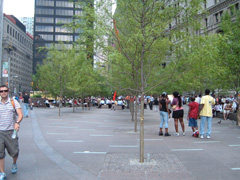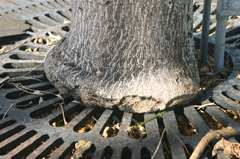Home > Urban/suburban design > Street tree design > Sidewalk cutouts
Sidewalk cutouts

If possible, plant in another area or design the space so there are no cutouts in the pavement. Long linear strips are better for trees than are cutouts. A sidewalk cutout (also called a treepit or tree well) is a very difficult place to grow a tree. Special provisions are needed to do this successfully.
Minimum cutout size is often considered 4 x 4 feet for small trees, but should be increased for larger-maturing trees (click here is see guidelines). Surface roots close to the
trunk on healthy trees in sidewalk cutouts often raise sidewalks. Trees with small-diameter main roots heave sidewalks less than other trees; palms and small-maturing 
Tree Selection - When choosing trees for such a site, be sure that soil drainage and soil compaction tests were conducted carefully. Unless soil is sandy, gravelly, or loamy, drainage and aeration are often poor and soil beneath the sidewalk is compacted. Roots of most trees grow poorly in these conditions and may remain in the loosened soil in the cutout. Those that manage to escape the soil in the cutout often grow directly under the sidewalk slab or along the curb, raising them up or displacing them.
Trees that tolerate both wet sites and drought often grow better in the unpredictable conditions found in cutouts than other trees. If soil in the cutout is sandy
and well drained, choose drought-tolerant trees without concern for flood tolerance.
Tree grates - Trees planted in cutouts with a tree grate need regular attention. Grates require periodic enlarging to accommodate trunk and root growth. If this is not performed, trees can die from strangulation of the trunk (see photo at left). Designate the agency that will maintain the tree grates BEFORE installing trees in grates, or do no install them. Some communities have outlawed tree grates because they kill trees if not maintained. Click here for alternatives to grates.

